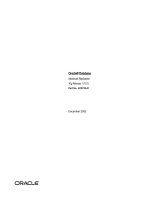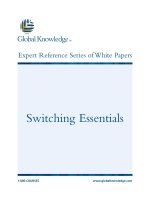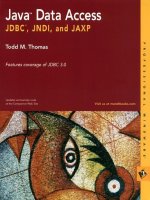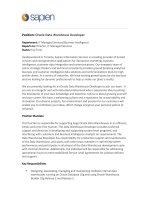Tài liệu Deserializing Data pptx
Bạn đang xem bản rút gọn của tài liệu. Xem và tải ngay bản đầy đủ của tài liệu tại đây (13.46 KB, 3 trang )
[ Team LiB ]
Recipe 5.5 Deserializing Data
Problem
You have a DataSet that has been serialized and written to a file. You want to recreate the
DataSet from this file.
Solution
Use the serializer object's Deserialize( ) method and cast the result as a DataSet.
The sample code loads a file stream containing a previously serialized DataSet in a
specified format and deserializes it to recreate the original DataSet.
The C# code is shown in Example 5-5
.
Example 5-5. File: DeserializeForm.cs
// Namespaces, variables, and constants
using System;
using System.Windows.Forms;
using System.IO;
using System.Data;
using System.Runtime.Serialization;
using System.Runtime.Serialization.Formatters;
using System.Runtime.Serialization.Formatters.Binary;
using System.Runtime.Serialization.Formatters.Soap;
using System.Xml.Serialization;
private OpenFileDialog ofd;
// . . .
private void goButton_Click(object sender, System.EventArgs e)
{
// Create and open the stream for deserializing.
Stream stream = null;
try
{
stream = File.Open(fileNameTextBox.Text, FileMode.Open,
FileAccess.Read);
}
catch(Exception ex)
{
MessageBox.Show(ex.Message, "Deserializing Data",
MessageBoxButtons.OK, MessageBoxIcon.Error);
return;
}
// Deserialize the DataSet from the stream.
DataSet ds = null;
try
{
if (xmlReadRadioButton.Checked)
{
ds = new DataSet( );
ds.ReadXml(stream);
}
else if (xmlSerializerRadioButton.Checked)
{
XmlSerializer xs = new XmlSerializer(typeof(DataSet));
ds = (DataSet)xs.Deserialize(stream);
}
else if(soapRadioButton.Checked)
{
SoapFormatter sf = new SoapFormatter( );
ds = (DataSet)sf.Deserialize(stream);
}
else if(binaryRadioButton.Checked)
{
BinaryFormatter bf = new BinaryFormatter( );
ds = (DataSet)bf.Deserialize(stream);
}
}
catch (System.Exception ex)
{
MessageBox.Show(ex.Message, "Deserializing Data",
MessageBoxButtons.OK, MessageBoxIcon.Error);
return;
}
finally
{
stream.Close( );
}
// Bind the DataSet to the grid.
dataGrid.DataSource = ds.DefaultViewManager;
MessageBox.Show("Deserialization complete.", "Deserializing Data",
MessageBoxButtons.OK, MessageBoxIcon.Information);
}
private void fileDialogButton_Click(object sender, System.EventArgs e)
{
// File dialog to save file
if(xmlReadRadioButton.Checked || xmlSerializerRadioButton.Checked)
ofd.Filter = "XML files (*.xml)|*.xml";
else if(soapRadioButton.Checked)
ofd.Filter = "SOAP files (*.soap)|*.soap";
else if(binaryRadioButton.Checked)
ofd.Filter = "Binary files (*.bin)|*.bin";
ofd.Filter += "|All files (*.*)|*.*";
ofd.FilterIndex = 0;
if (ofd.ShowDialog( ) == DialogResult.OK)
fileNameTextBox.Text = ofd.FileName;
}
Discussion
This sample deserializes any of the serialized DataSet objects from Recipe 5.4
.
The sample allows the user to select a file and specify a serialization type. The
appropriate serializing object is created and in the case of the XmlSerializer object, its
type is specified in the constructor. The Deserialize( ) method of the serializer object is
then used to deserialize the file stream into an object graph. This is then cast to a DataSet
to complete the deserialization.
See the discussion in Recipe 5.4
for more information about the serialization and the
formatter classes that can serialize ADO.NET objects.
[ Team LiB ]









